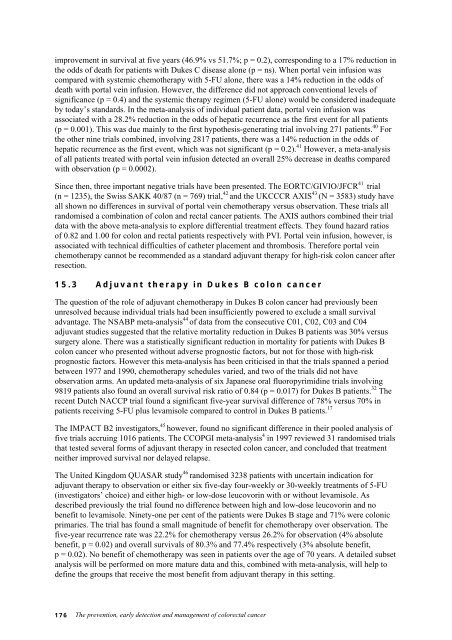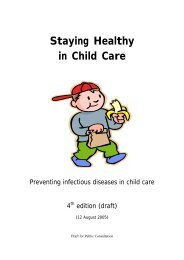Clinical Practice Guidelines - National Health and Medical Research ...
Clinical Practice Guidelines - National Health and Medical Research ...
Clinical Practice Guidelines - National Health and Medical Research ...
Create successful ePaper yourself
Turn your PDF publications into a flip-book with our unique Google optimized e-Paper software.
improvement in survival at five years (46.9% vs 51.7%; p = 0.2), corresponding to a 17% reduction in<br />
the odds of death for patients with Dukes C disease alone (p = ns). When portal vein infusion was<br />
compared with systemic chemotherapy with 5-FU alone, there was a 14% reduction in the odds of<br />
death with portal vein infusion. However, the difference did not approach conventional levels of<br />
significance (p = 0.4) <strong>and</strong> the systemic therapy regimen (5-FU alone) would be considered inadequate<br />
by today’s st<strong>and</strong>ards. In the meta-analysis of individual patient data, portal vein infusion was<br />
associated with a 28.2% reduction in the odds of hepatic recurrence as the first event for all patients<br />
(p = 0.001). This was due mainly to the first hypothesis-generating trial involving 271 patients. 40 For<br />
the other nine trials combined, involving 2817 patients, there was a 14% reduction in the odds of<br />
hepatic recurrence as the first event, which was not significant (p = 0.2). 41 However, a meta-analysis<br />
of all patients treated with portal vein infusion detected an overall 25% decrease in deaths compared<br />
with observation (p = 0.0002).<br />
Since then, three important negative trials have been presented. The EORTC/GIVIO/JFCR 41 trial<br />
(n = 1235), the Swiss SAKK 40/87 (n = 769) trial, 42 <strong>and</strong> the UKCCCR AXIS 43 (N = 3583) study have<br />
all shown no differences in survival of portal vein chemotherapy versus observation. These trials all<br />
r<strong>and</strong>omised a combination of colon <strong>and</strong> rectal cancer patients. The AXIS authors combined their trial<br />
data with the above meta-analysis to explore differential treatment effects. They found hazard ratios<br />
of 0.82 <strong>and</strong> 1.00 for colon <strong>and</strong> rectal patients respectively with PVI. Portal vein infusion, however, is<br />
associated with technical difficulties of catheter placement <strong>and</strong> thrombosis. Therefore portal vein<br />
chemotherapy cannot be recommended as a st<strong>and</strong>ard adjuvant therapy for high-risk colon cancer after<br />
resection.<br />
15.3 Adjuvant therapy in Dukes B colon cancer<br />
The question of the role of adjuvant chemotherapy in Dukes B colon cancer had previously been<br />
unresolved because individual trials had been insufficiently powered to exclude a small survival<br />
advantage. The NSABP meta-analysis 44 of data from the consecutive C01, C02, C03 <strong>and</strong> C04<br />
adjuvant studies suggested that the relative mortality reduction in Dukes B patients was 30% versus<br />
surgery alone. There was a statistically significant reduction in mortality for patients with Dukes B<br />
colon cancer who presented without adverse prognostic factors, but not for those with high-risk<br />
prognostic factors. However this meta-analysis has been criticised in that the trials spanned a period<br />
between 1977 <strong>and</strong> 1990, chemotherapy schedules varied, <strong>and</strong> two of the trials did not have<br />
observation arms. An updated meta-analysis of six Japanese oral fluoropyrimidine trials involving<br />
9819 patients also found an overall survival risk ratio of 0.84 (p = 0.017) for Dukes B patients. 32 The<br />
recent Dutch NACCP trial found a significant five-year survival difference of 78% versus 70% in<br />
patients receiving 5-FU plus levamisole compared to control in Dukes B patients. 17<br />
The IMPACT B2 investigators, 45 however, found no significant difference in their pooled analysis of<br />
five trials accruing 1016 patients. The CCOPGI meta-analysis 4 in 1997 reviewed 31 r<strong>and</strong>omised trials<br />
that tested several forms of adjuvant therapy in resected colon cancer, <strong>and</strong> concluded that treatment<br />
neither improved survival nor delayed relapse.<br />
The United Kingdom QUASAR study 46 r<strong>and</strong>omised 3238 patients with uncertain indication for<br />
adjuvant therapy to observation or either six five-day four-weekly or 30-weekly treatments of 5-FU<br />
(investigators’ choice) <strong>and</strong> either high- or low-dose leucovorin with or without levamisole. As<br />
described previously the trial found no difference between high <strong>and</strong> low-dose leucovorin <strong>and</strong> no<br />
benefit to levamisole. Ninety-one per cent of the patients were Dukes B stage <strong>and</strong> 71% were colonic<br />
primaries. The trial has found a small magnitude of benefit for chemotherapy over observation. The<br />
five-year recurrence rate was 22.2% for chemotherapy versus 26.2% for observation (4% absolute<br />
benefit, p = 0.02) <strong>and</strong> overall survivals of 80.3% <strong>and</strong> 77.4% respectively (3% absolute benefit,<br />
p = 0.02). No benefit of chemotherapy was seen in patients over the age of 70 years. A detailed subset<br />
analysis will be performed on more mature data <strong>and</strong> this, combined with meta-analysis, will help to<br />
define the groups that receive the most benefit from adjuvant therapy in this setting.<br />
176<br />
The prevention, early detection <strong>and</strong> management of colorectal cancer

















